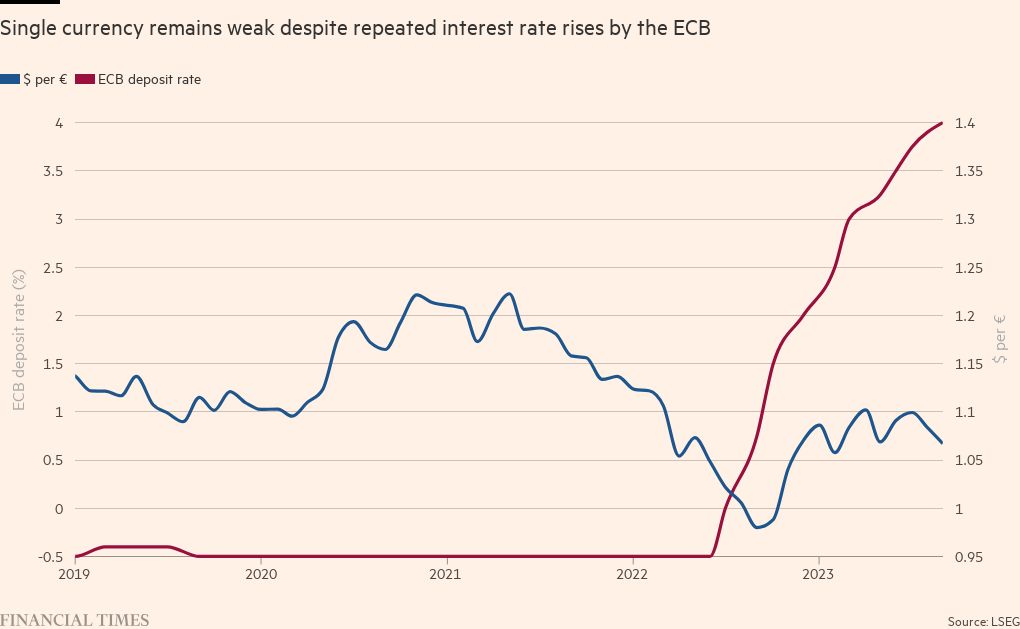Euro’s weakness reveals the worries over the eurozone economy


Roula Khalaf, Editor of the FT, selects her favourite stories in this weekly newsletter.
The response in the euro to this week’s latest crank higher in interest rates tells us a good deal about how investors are looking at the world.
The inflation-focused European Central Bank on Thursday lifted deposit rates by a quarter of a point to 4 per cent — the highest point in the common currency’s existence.
By Deutsche Bank’s calculations, this cycle of rate rises stands out by even longer historical standards. “If you go back before the ECB’s formation and look at previous tightening episodes from the German Bundesbank, they’ve now delivered as much tightening in the space of 15 months as the Bundesbank did from the start of our data in 1948,” wrote Jim Reid and colleagues at the bank. Those upside-down days of negative rates feel like another age.
On paper, this should boost the euro. After all, currencies love nothing more than higher rates, as a rule, and the decision was something of a surprise — just a couple of days beforehand, it was seen as a coin toss between a hold and a rise.
But, no dice. The currency dropped by 0.8 per cent against the dollar that day, leaving it just a nose above $1.06 — a three-month low. It was one of the poorest days for the common currency all year — only five previous days in 2023 have brought heavier declines, and the euro’s losing streak now runs to nine weeks in a row. Reminders in the post-meeting press conference from ECB president Christine Lagarde that she remains willing to raise rates further were not enough to turn the tide.
“It doesn’t make for great optics when a central bank tightens policy only to see its currency drop straight after the decision,” said Bas van Geffen, a senior macro strategist at Rabobank, in a note to clients.
Paul Donovan, chief economist at UBS Wealth Management, described the rise in rates as a “burden”. “As most current drivers of inflation in the eurozone are not interest rate sensitive, the inflation impact of this rate hike is questionable,” he said. “ECB president Lagarde attempted hawkishness at the press conference, but markets ignored the tone.”
The massaging of expectations continues apace. Some of those directly involved in the ECB’s policy decisions insist another rise in rates before the end of the year remains a possibility — a prospect that some market observers, including van Geffen at Rabobank, take seriously.
But broadly, few truly believe the central bank really will raise rates further, especially while the region’s economy feels the strain from the tighter policy enacted so far and from the impact of weaker Chinese demand on German manufacturing. Conspicuously, staff at the central bank cut back their euro area growth forecasts quite substantially, pencilling in 0.7 per cent growth for this year, from 0.9 per cent previously, and lopping off half a percentage point from next year’s forecast, to 1 per cent.
“The hike could tip the balance,” warned Katharine Neiss, chief European economist at PGIM Fixed Income. “It risks triggering a rapid economic slowdown and below-target inflation in the medium term.”
All in all, it is just not a great recipe for euro bulls, if indeed there are any left. French bank BNP Paribas has even used the dreaded F-word (not that one) to describe the currency. It says it continues to like using the euro as a so-called funder — something you sell to finance more rewarding and higher yielding bets elsewhere.
This is a label generally slapped on to a currency only if its interest rates are stuck at or close to zero, or even lower (hello, Japanese yen). For the term to apply to a currency bolstered by its highest rates in history really underlines how the end of the low inflation era has upended market mechanics.
The euro’s latest stumble also highlights another broader point, which is the yawning gap between investor perceptions of the US and those of pretty much everywhere else. Crucially, weakness in the euro is not as pronounced against other currencies. It has gone nowhere against sterling or the yen since May. Instead, it is suffering particularly against the dollar, which just keeps on plugging higher. The DXY index tracking its value against a basket of other currencies has gained more than 5 per cent since July, while rosy US economic data pushes recession risks ever further out to the future.
The euro’s latest wobble also forms yet another big signal that investors think Europe’s luck has run out. The startling resilience in the euro area economy that supported the currency and made the region’s stocks such an unusual hot pick at the start of this year is clearly fading away.
“[Currency markets are] never only about monetary policy, even if in the short to medium term, interest rates are usually the biggest driver of exchange rates,” said Kit Juckes, a macro strategist at Société Générale in London. But the drop in the euro on the ECB’s lower growth forecasts is something to watch. “The euro can easily trade below $1.05 if we don’t get any positive surprises from the real economy data in Europe soon,” he said. Holding your breath for those positive surprises seems a risky strategy.

Comments